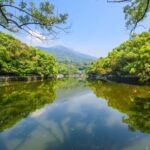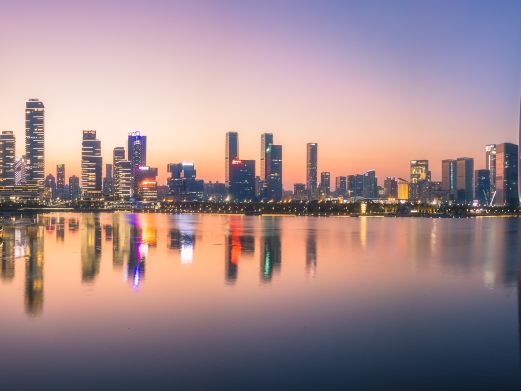Tongtianyan is located in the northwestern suburbs of Ganzhou, about 10 kilometers away from the urban area. It is named because there are many natural caves in the mountain, and one of the cave roofs has a hole through which one can see the sky. For outsiders, Tongtianyan may be relatively unknown, but it is a very worthwhile scenic spot locally. Here, there are not only very typical Danxia landform landscapes, but also cultural landscapes such as cliff inscriptions by Wang Yangming, caves built for软禁 Zhang Xueliang, and summer villas. Although the stone niche statue groups in the mountains cannot be compared with grottoes like the Mogao Caves, they are also outstanding in Jiangnan. The scenic area can be divided into two parts: the ancient stone carving area and the modern leisure area. The walking trails can roughly be regarded as two nested loops. The essence of the stone carving area is concentrated in the inner loop near the scenic area gate, mainly including five caves such as Guanxin Rock, Wanggui Rock, Longhu Rock, Tongtian Rock, and Cuiwei Rock, which are the key points of the tour. The outer circle is mainly for climbing mountains and visiting artificial scenic spots. Walking the entire route usually takes most of the day. Entering the scenic area, passing a small artificial lake and waterfall, and then walking up two or three hundred steps to reach the inner circle of the scenic area. The first one to arrive is Guanxin Rock. Here, there are small caves within large caves. It is said that this was once the lecture place of Wang Yangming, a philosopher in the Ming Dynasty. Walking along the stone steps, not far away is Wanggui Rock. There is a Danxia through cave on the mountainside of Wanggui Rock. Especially in summer, the cool breeze is refreshing, making people reluctant to leave. What is worth seeing here is the poem inscription by Wang Yangming. Passing through the secluded valley, one can see the arhat statues on the precipitous cliff. In front of the cave is the dance hall. Nowadays, only some photos and the like can be seen inside. After enjoying the Song Dynasty stone carvings in Longhu Rock, it is the core tourist area of Tongtianyan. This is a circular mountain wall. The eight Tang Dynasty statues on the cliff are the works of Tongtianyan Grottoes with a long history. In the stone niche, the meditation statue of Vairocana Buddha in the Song Dynasty and the stacked reliefs of five hundred arhats on the adjacent stone wall are magnificent. In the central area, there are also Guangfu Zen Forest built along the mountain, Shuanggui Hall where General Zhang Xueliang was imprisoned, summer mountain houses, etc. The environment is quiet and elegant. One can burn incense and pray for blessings in the Zen temple. Cuiwei Rock is adjacent to Tongtian Rock. Here, there are the cliff inscriptions of ‘Tongtianyan’, which can be regarded as one of the symbols of the scenic area. There are many inscriptions with a long history around it, which can be carefully read. At this point, the tour of ancient stone carvings is over. From here, there is a fork in the road. One leads to the modern leisure area, and the other leads to the Wangjiang Pavilion (Qunyu Pavilion) on the mountain. Standing on the Wangjiang Pavilion, one can have a panoramic view of the beautiful mountains and rivers in the distance. Tourists mainly interested in cultural landscapes can return after visiting the Wangjiang Pavilion. If there is enough time, one can continue to go to the modern leisure area for a stroll. Most of the landscapes here are artificially built later. The more worthwhile ones to see are the more than 20-meter-long Danxia reclining Buddha, Thousand Buddha Cave, the Wealth God Temple, and statue groups of historical celebrities in Ganzhou such as Yue Fei, Zhou Dunyi, and Xin Qiji.
Further away, there are a series of leisure and amusement spots such as an ecological maze and the Twelve Chinese Zodiac Gardens.
Opening hours: Open all year round from 08:00 to 17:00.
Preferential policies:
Children: Children under 6 years old (including) (with valid certificates such as household register and birth certificate) or children under 1.2 meters (including) in height are exempted from tickets. Free.
Students: National college students (student ID), middle school students (adults) with valid certificates (ID card, student ID), discounted; full-time postgraduate students and above with ID card and graduation certificate, free.
Elderly: Those over 65 years old (including) with ID card, senior citizen card and other valid certificates, free; those aged 60 (including) to 65 years old (excluding) with ID card, senior citizen card and other valid certificates, discounted.
Military personnel: Active-duty military personnel with valid certificates, free.
Beneficiaries of special care and compensation: Beneficiaries of special care and compensation enjoying pensions and subsidies with valid certificates, free.
Disabled people: With valid certificates, free.
Journalists: Journalists with press cards issued by the State Press and Publication Administration, free.
Tour guides: Tour guides with IC cards of tourist guide certificates issued by the National Tourism Administration, free.
Other people: High-level talent service cards of Jiangxi Province; conversion certificates, free.
Tongtianyan Scenic Area
Tongtianyan is located in the northwestern suburbs of Ganzhou, about 10 kilometers away from the urb[...]









